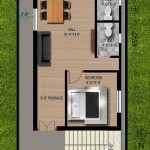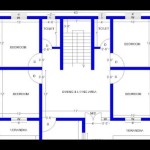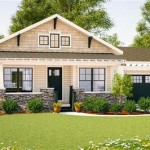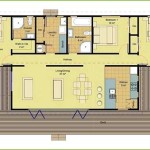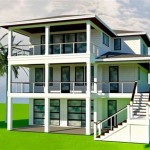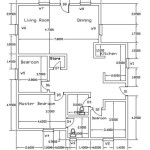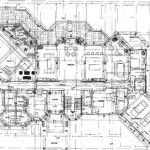Understanding the Floor Plan of Ranch Style House Designs in Japan
Ranch style houses, originating in the United States, are characterized by their single-story layout, low-pitched roof, and typically open floor plans. When imported to Japan, these designs undergo adaptations to suit the unique cultural context, environmental conditions, and specific needs of Japanese homeowners. Understanding the floor plan of a ranch style house in Japan requires examining the interplay between the original design principles and the modifications implemented to integrate traditional Japanese elements and address practical considerations.
The core concept of a ranch style house focuses on horizontal living, emphasizing accessibility and a connection to the outdoors. In Japan, this fundamental principle is generally maintained, but adaptations are introduced to maximize space utilization in a country where land is often at a premium, and to incorporate features that resonate with Japanese lifestyle and aesthetic preferences.
A typical Japanese ranch style house often features a more compact footprint compared to its American counterpart. This is partly due to land scarcity and the preference for efficient living spaces. While the open floor plan remains a key characteristic, there's often a more defined separation between living areas and private spaces, catering to the Japanese emphasis on privacy and tranquility within the home.
Key Point 1: Integration of Traditional Japanese Elements
One of the most significant aspects of understanding a Japanese ranch style house lies in recognizing the integration of traditional Japanese design elements within the framework of a Western architectural style. These elements contribute significantly to the character and functionality of the home.
The *genkan*, or entryway, is a near-universal feature. It serves as a transition space between the outside world and the interior of the house, where shoes are removed before stepping onto the main living area. This practice is deeply rooted in Japanese culture and hygiene. The *genkan* area typically features a built-in shoe storage unit and a step-up to the main floor level.
While completely open floor plans are less common than in the prototypical American ranch, flexible spaces are often achieved through the use of sliding doors, or *fusuma* and *shoji*. *Fusuma* are opaque sliding doors, often made of paper or fabric stretched over a wooden frame, which can be used to divide a large room into smaller, more private spaces. *Shoji* are translucent sliding doors, typically made with a wooden frame and paper panels, allowing light to filter through while maintaining a degree of privacy. These elements permit homeowners to reconfigure their living spaces to suit different needs and occasions.
The inclusion of a *tatami* room, or *washitsu*, also reflects the integration of traditional Japanese design. *Tatami* mats are made of woven rush grass and provide a comfortable and aesthetically pleasing surface for sitting, sleeping, and other activities. A *washitsu* is typically a versatile space that can serve as a guest room, a study, or a space for meditation. The dimensions of the *washitsu* are often based on the standard size of a *tatami* mat, influencing the overall planning of the floor plan.
The bathroom layout often incorporates a separate bathing area, or *furoba*, and a separate toilet. This separation allows for more efficient use of the bathroom space and aligns with Japanese bathing customs. The *furoba* typically includes a deep soaking tub, or *ofuro*, which is used for relaxation and cleansing.
Key Point 2: Adaptations for Environmental Considerations
Japanese ranch style houses, like all Japanese architecture, are adapted to cope with the country's specific environmental challenges, including earthquakes, typhoons, and periods of high humidity. These considerations influence the materials used, the structural design, and the layout of the floor plan.
Earthquake resistance is a paramount concern. Japanese building codes mandate stringent structural requirements to ensure that homes can withstand seismic activity. Ranch style houses, with their single-story construction, are inherently more resistant to earthquakes than multi-story buildings. The floor plan is often designed to provide structural stability, with strategically placed load-bearing walls and reinforced foundations.
The design also needs to consider the high levels of humidity that are common in many parts of Japan. Adequate ventilation is crucial to prevent mold and mildew growth. Floor plans often incorporate features such as large windows and strategically placed air vents to promote cross-ventilation. The use of breathable building materials, such as wood and natural plaster, also helps to regulate humidity levels.
The roof design is also influenced by environmental considerations. While ranch style houses typically have low-pitched roofs, Japanese ranch style houses may incorporate features such as deep eaves to provide shade and protect the walls from rain and snow. The roofing material is often chosen for its durability, weather resistance, and ability to withstand the elements.
The placement of windows and doors is carefully considered to maximize natural light while minimizing heat gain and loss. In warmer regions, windows may be shaded by eaves or screens to reduce the amount of direct sunlight entering the house. In colder regions, windows may be smaller and double-paned to improve insulation and reduce heat loss.
Key Point 3: Space Efficiency and Functional Layout
Given the limited land availability and the emphasis on efficient living, Japanese ranch style house floor plans prioritize space efficiency and functional layouts. Every square meter is carefully considered and utilized to maximize the usability of the home.
Multi-functional spaces are a common feature. Rooms may be designed to serve multiple purposes, such as a living room that can be transformed into a guest room or a dining room that can be used as a workspace. The use of *fusuma* and *shoji* allows for flexible partitioning of spaces, enabling homeowners to adapt their living areas to suit different needs.
Storage is carefully integrated into the floor plan to minimize clutter and maximize living space. Built-in storage units, such as *oshiire* (Japanese closets) and *tansu* (traditional chests of drawers), are commonly incorporated into the design. These storage solutions are designed to be both functional and aesthetically pleasing, blending seamlessly into the overall design of the home.
The kitchen layout is often compact and efficient, designed to minimize movement and maximize workspace. Japanese kitchens typically feature a sink, a stovetop, a refrigerator, and storage space for cooking utensils and ingredients. The layout is often designed to allow for easy access to all of these elements, minimizing wasted steps and making cooking more efficient.
The orientation of the house on the lot is carefully considered to maximize natural light and ventilation. The floor plan is often designed to take advantage of the sun's path, with living areas facing south to maximize sunlight exposure and bedrooms facing east to capture the morning sun. The placement of windows and doors is also carefully considered to maximize cross-ventilation and minimize the need for artificial lighting and air conditioning.
The connection to the outside is often maintained through the incorporation of a small garden or courtyard, or *tsubo-niwa*. This allows for a visual connection to nature, even in urban areas. The *tsubo-niwa* can also serve as a source of natural light and ventilation, further enhancing the livability of the home.
In summary, the floor plan of a ranch style house design in Japan represents a carefully considered synthesis of Western architectural principles and traditional Japanese design elements. It also reflects the need to adapt to the specific environmental conditions and the emphasis on space efficiency and functional layouts. By understanding these key aspects, one can gain a deeper appreciation for the unique characteristics of Japanese ranch style house designs.

Traditional Japanese House Floor Plans With Drawings Upgradedhome Com

Traditional Japanese House Floor Plans With Drawings Upgradedhome Com

Stonebrook Modern Ranch Home Mb 2594 House Plan Barn Plans

House Plan 10507 Ranch Style With 2189 Sq Ft 3 Bed 1 Bath Coolhouseplans Com

Pin By Kim Slocum On Floor Plans Traditional Japanese House Home Design

6 Open Floor House Designs To Make Your Space Look Bigger And Better

House Split Into Four Separate Buildings Open Spaces In Between The Ultimate Courtyard

House Plan 69238 Traditional Style With 2320 Sq Ft 2 Bed Ba Coolhouseplans Com

Denali House Plan One Story Traditional Craftsman Home Design Mf 2884

Modern Ranch House Plan 3 Bed 2 Bath Porch
Related Posts

